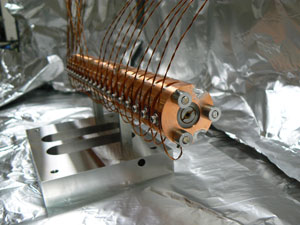 AUSTIN, Texas—An atomic coilgun that slows and stops atoms has been developed, report physicists from The University of Texas at Austin in the New Journal of Physics.
AUSTIN, Texas—An atomic coilgun that slows and stops atoms has been developed, report physicists from The University of Texas at Austin in the New Journal of Physics.
Dr. Mark Raizen and his colleagues used the new coilgun to slow neon atoms, and Raizen said that the method could be used with a wide variety of atoms.
“Our method will be applicable to most of the periodic table of atoms and to certain molecules, so there are many new doors that will be opened by this research,” said Raizen, the Sid W. Richardson Foundation Regents Chair in Physics. “This will facilitate the detailed study of atomic and molecular properties.”
Raizen’s work continues a long-standing effort to control atomic motion, which for many years has been accomplished by laser cooling. However, laser cooling—a method also used in the Raizen lab—only works for a small number of atoms.
In contrast, nearly all elements and a wide range of molecules are affected by magnetic forces, or are paramagnetic, which means that the atomic coilgun has much wider applicability.
The coilgun works by shooting a supersonic beam of atoms though a set of 18 magnetic coils. The coils slow the atoms by making them climb a “magnetic hill.” The hill is removed before the atoms have time to roll off and regain speed.
Raizen’s research group was inspired by a coilgun developed for launching projectiles at hyper speeds by the Center for Electromechanics, also at The University of Texas at Austin.
Raizen ultimately plans on using the gun to trap atomic hydrogen, which he said has been the Rosetta Stone of physics for many years and is the simplest and most abundant atom in the periodic table.
Precision spectroscopy of the two isotopes of hydrogen—deuterium and tritium—continues to be of great interest to atomic and nuclear physics. Tritium is the simplest radioactive element and serves as an ideal system for the study of beta decay, which may be the only way to determine the electron neutrino rest mass, one of the most pressing questions in physics and astronomy today.
“Despite these very important features, hydrogen has remained very difficult to control and trap, and deuterium and tritium have not yet been trapped,” Raizen said. “The [atomic coilgun] method of magnetic slowing will allow us to pursue this dream."
Having successfully designed and used an 18-coil gun, the team is now developing a 64-stage device to advance their research in this area.
For more information contact: Dr. Mark Raizen, (512) 471-4753, raizen@physics.utexas.edu

















Comments